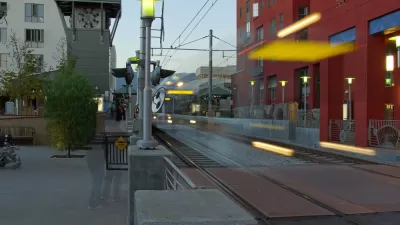Advocates for a more multi-modal lifestyle in Los Angeles have achieved tremendous successes in the last decade. But ongoing bike lane controversies shows there's still a long way to go.
Advocates for complete streets and a more multi-modal lifestyle in Los Angeles have achieved tremendous successes in the last decade. But ongoing controversies about bike lanes shows there's still a long way to go.
Drew Reed begins a recent article for Citymetric by noting that Los Angeles residents have grown more supportive of alternative modes of transportation, citing the ambitious rail build-out enabled by the half-cent sales tax approved by Measure R as an example. Yet, when it comes to bike lanes, a less auto-centric vision for transportation has been harder to implement, with about 200 miles built out of a plan that calls for 1,684 miles of bike infrastructure.
Reed cites the example a proposed, now defunct, bike lane in Northeast Los Angeles as an example of the dysfunction that still surrounds complete streets planning in Los Angeles. "The planned bike lane for Figueroa in Northeast Los Angeles has become a case study in exactly how much can go wrong with a seemingly good plan. In documents released in 2010, the area was listed as a priority." That after Councilmember Gil Cedillo pulled the plug on the lane, claiming that the bike lane would impede the ability of emergency vehicles to navigate the street.
Reed compares that example with that of the MyFigueroa project, which would add a protected bike lane, among other complete streets improvements, on a stretch of Figueroa Street located south of Downtown Los Angeles. That project recently passed sizable hurdles in the form of wealthy, landowning businesses located along route of the proposed complete streets project.
FULL STORY: Los Angeles: A Tale of Two Bike Lanes

Planetizen Federal Action Tracker
A weekly monitor of how Trump’s orders and actions are impacting planners and planning in America.

Chicago’s Ghost Rails
Just beneath the surface of the modern city lie the remnants of its expansive early 20th-century streetcar system.

San Antonio and Austin are Fusing Into one Massive Megaregion
The region spanning the two central Texas cities is growing fast, posing challenges for local infrastructure and water supplies.

Since Zion's Shuttles Went Electric “The Smog is Gone”
Visitors to Zion National Park can enjoy the canyon via the nation’s first fully electric park shuttle system.

Trump Distributing DOT Safety Funds at 1/10 Rate of Biden
Funds for Safe Streets and other transportation safety and equity programs are being held up by administrative reviews and conflicts with the Trump administration’s priorities.

German Cities Subsidize Taxis for Women Amid Wave of Violence
Free or low-cost taxi rides can help women navigate cities more safely, but critics say the programs don't address the root causes of violence against women.
Urban Design for Planners 1: Software Tools
This six-course series explores essential urban design concepts using open source software and equips planners with the tools they need to participate fully in the urban design process.
Planning for Universal Design
Learn the tools for implementing Universal Design in planning regulations.
planning NEXT
Appalachian Highlands Housing Partners
Mpact (founded as Rail~Volution)
City of Camden Redevelopment Agency
City of Astoria
City of Portland
City of Laramie



























